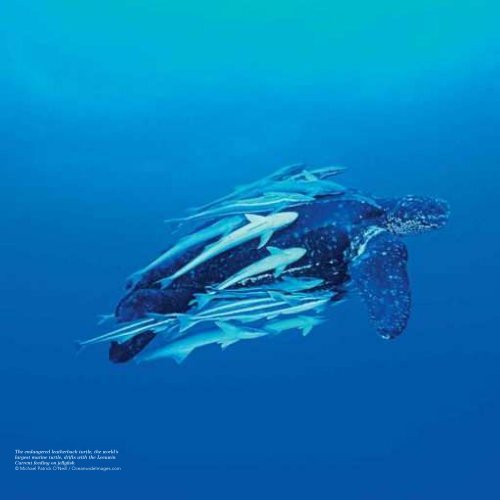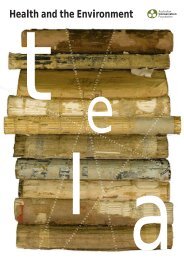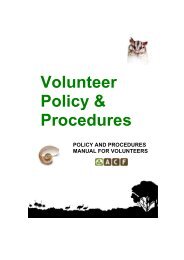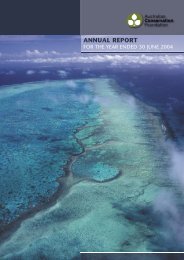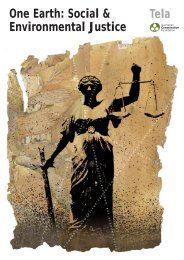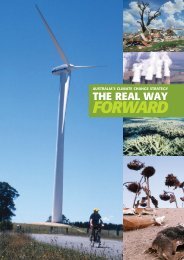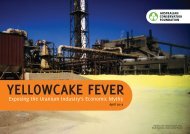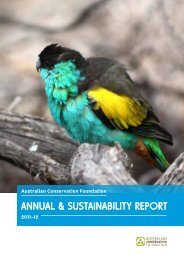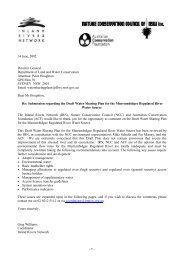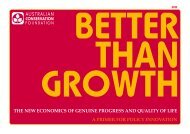Protecting Western Australia's Big Blue Backyard - The Pew ...
Protecting Western Australia's Big Blue Backyard - The Pew ...
Protecting Western Australia's Big Blue Backyard - The Pew ...
- No tags were found...
Create successful ePaper yourself
Turn your PDF publications into a flip-book with our unique Google optimized e-Paper software.
<strong>The</strong> endangered leatherback turtle, the world’slargest marine turtle, drifts with the LeeuwinCurrent feeding on jellyfish© Michael Patrick O’Neill / OceanwideImages.com<strong>The</strong> continuing goodhealth of the marinewaters from Kalbarrito Eucla is integralto the lives of <strong>Western</strong>AustraliansPROTECTING WESTERN AUSTRALIA’STHREATENED MARINE LIFESTYLELifestyle, culture and economy come togetherin <strong>Western</strong> Australia’s big blue backyard.Consider these images of life in the West:– piling the kids and spouse in a fully loadedwagon and heading to the beach—a typicalsummer holiday for the family– rock lobsters for Christmas dinner, prawns onthe barbie out back and deep-fried scallopsfrom the fish and chip shop—all locally caught– lying on the Cottesloe Beach turningrotisserie-like for an even tan, surfing thebreak at Margaret River, sailing along oneof the windiest coasts in the world atGeraldton—are just part of the lifestyle– feet up in the tinnie waiting for a fish to bite,leaning over the charter boat’s handrail watchingfor humpback whales off Fremantle, divingamong a school of western blue groper—peopleand marine life strongly connect in<strong>Western</strong> Australia– miners from Kalgoorlie and farmers nearNorseman cleansing themselves of dust anddung at Esperance Beach, stuck in a bicycletraffic jam on ‘Rotto’, driving through forestsand wineries followed by a sunset walk along anempty south-coast beach—great holiday snaps– setting commercial lobster pots off theHoutman-Abrolhos Islands, hauling anchor atFremantle Port to send a load of alumina aroundthe world, exploring the prospects for oil—eachconnects industry and the marine environment.<strong>The</strong> connection between <strong>Western</strong> Australians andtheir marine environment is arguably stronger thananywhere else in the nation.Eighty-five per cent of Australians live within50 kilometres of the coast, which is a very highfigure internationally. But in <strong>Western</strong> Australianearly 90 per cent of its two million people live injust eight of the population centres found alongthe 2500 kilometres of coast between Kalbarriand Eucla. <strong>The</strong>se centres are Geraldton, Perth,Fremantle, Bunbury, Busselton, Mandurah,Albany and Esperance.In a state that has a population growing faster thanany other in Australia, increasing by nearly 1000people each week, it is the Kalbarri to Eucla regionthat will continue to be the focus of the <strong>Western</strong>Australian marine lifestyle.<strong>The</strong> marine environment from Kalbarrito Eucla—one million square kilometres inarea—is remarkable and its marine life globallyunique courtesy of the Leeuwin Current.As well as its special natural values, each yearthe region’s marine environment deliverssignificant social and economic benefits.Commercial fisheries annually harvest around25,000 tonnes of seafood, including the catch ofthe western rock lobster fishery, Australia’s mostlucrative fishery. <strong>The</strong> region also has a significantshare of the state’s $3 billion tourism industry andthe $45 million whale-watching industry, while thePort of Fremantle handles $15 billion of trade.<strong>The</strong> future of <strong>Western</strong> Australia is inextricablylinked to the health of the marine environmentfrom Kalbarri to Eucla. Despite this, the region’smarine environment faces considerable threatsand lacks any marine protected areas. <strong>The</strong> socialand economic benefits it provides are increasinglyat risk, and the <strong>Western</strong> Australian marine lifestyleis under threat.This has not gone unnoticed by <strong>Western</strong>Australians who have begun to recognise the signsthat all is not well in their big blue backyard.<strong>The</strong>re is a high level of community awarenessin <strong>Western</strong> Australia about commercial andrecreational overfishing of the big reef fish speciesknown as the ‘Vulnerable 5’. <strong>Western</strong> Australianshave also observed the decline of water quality,marine life and habitats in the Swan River,Cockburn Sound and the Peel Harvey Inlet.Algal blooms, fish kills, the loss of seagrass nurseryareas for fish, and even respiratory ailments foryoung people, are some of the results.With strong links existing between the life inestuaries, inshore and offshore waters, thesecoastal impacts could become a region-wideproblem as the population grows, coastal housingspreads and the petroleum and shipping industriesexpand. This will put further pressure on therelationship that <strong>Western</strong> Australians have withtheir big blue backyard.<strong>The</strong>n there is the factor of climate change.Rising global temperatures could alter theinfluence of ocean currents like the LeeuwinCurrent, with major implications for marine lifeas well as <strong>Western</strong> Australia’s fisheries. Climatechange could also increase the acidity of marinewaters to a level that dissolves the shells of manymarine animals. A predicted rise in sea level ofclose to one metre this century would flood theregion’s beaches and rock pools that are so mucha part of local seaside life.<strong>The</strong> continuing good health of the marine watersfrom Kalbarri to Eucla is integral to the livesof <strong>Western</strong> Australians. Recent polling by the<strong>Pew</strong> Environment Group showed that <strong>Western</strong>Australians view marine protection as highlyimportant and want their big blue backyardprotected, both from current threats and impactsand those looming on the horizon.Of those polled, 73 per cent said that marineprotection was very important to them.According to 75 per cent of respondents, therewas not enough marine protection, and almost50 per cent called for protection to cover at least30 per cent of the marine environment.<strong>The</strong> Conservation Council of <strong>Western</strong> Australia,the Australian Conservation Foundation,<strong>The</strong> Wilderness Society, WWF-Australia,the Australian Marine Conservation Society,<strong>The</strong> Nature Conservancy and the <strong>Pew</strong> EnvironmentGroup are bringing community, science and goodpublic policy together to assist the AustralianGovernment in establishing a CAR network oflarge no-take marine reserves to protect themarine life in <strong>Western</strong> Australia’s bigblue backyard.7


